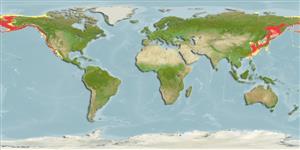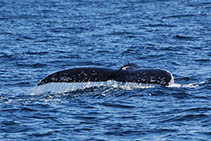Advertisement
Eschrichtius robustus (Lilljeborg, 1861)
Gray whale| Native range | All suitable habitat | Point map | Year 2050 |

|
| This map was computer-generated and has not yet been reviewed. |
| Eschrichtius robustus AquaMaps Data sources: GBIF OBIS |
United States (contiguous states) country information
Common names:
[No common name]
Occurrence: native
Salinity: marine
Abundance: | Ref:
Importance: | Ref:
Aquaculture: never/rarely | Ref:
Regulations: no regulations | Ref:
Uses: no uses
Comments: Skeletal parts unearthed from about A.D. 1675 in the eastern United States based on historical accounts in New England in the early 1700s (Ref. 1522). C: Refs. 1522, 3753, 74613, 94794.
National Checklist:
Country Information: https://www.cia.gov/library/publications/resources/the-world-factbook/geos/us.html
National Fisheries Authority: http://www.nmfs.gov
Occurrences: Occurrences Point map
Main Ref: Rice, D.W., 1998
National Database:
Occurrence: native
Salinity: marine
Abundance: | Ref:
Importance: | Ref:
Aquaculture: never/rarely | Ref:
Regulations: no regulations | Ref:
Uses: no uses
Comments: Skeletal parts unearthed from about A.D. 1675 in the eastern United States based on historical accounts in New England in the early 1700s (Ref. 1522). C: Refs. 1522, 3753, 74613, 94794.
National Checklist:
Country Information: https://www.cia.gov/library/publications/resources/the-world-factbook/geos/us.html
National Fisheries Authority: http://www.nmfs.gov
Occurrences: Occurrences Point map
Main Ref: Rice, D.W., 1998
National Database:
Common names from other countries
Classification / Names Tên thường gặp | Các synonym ( Các tên trùng) | Catalog of Fishes (gen., sp.) | ITIS | CoL | WoRMS
Environment: milieu / climate zone / depth range / distribution range Sinh thái học
Tầng nổi; Ở đại duơng, biển (Tài liệu tham khảo 75906); Mức độ sâu 1 - 2500 m, usually 30 - 500 m. Tropical; 90°N - 0°S, 115°E - 105°W
Distribution Các nước | Các khu vực của FAO | Các hệ sinh thái | Những lần xuất hiện | Những chỉ dẫn
Pacific Ocean, Atlantic Ocean and the Arctic: Extinct in North Atlantic; two populations in North Pacific. Tropical to polar. [western population: IUCN 2010 (Ref. 84930): CR, C2a(ii);E.]
Length at first maturity / Bộ gần gũi / Weight / Age
Maturity: Lm 1,220.0 range ? - ? cm Max length : 1,500 cm TL con đực/không giới tính; (Tài liệu tham khảo 1394); Khối lượng cực đại được công bố: 35.0 t (Tài liệu tham khảo 1394); Tuổi cực đại được báo cáo: 48 các năm (Tài liệu tham khảo 128170)
Lives within a few tens of kilometers of shore. Bottom feeders that feed primarily on swarming mysids and tube-dwelling amphipods in the northern parts of their range, but are also known to take red crabs, baitfish, and other food opportunistically. The North Atlantic stock was apparently wiped-out by whalers in the 18th century. A western North Pacific (Korean) stock may also have been extirpated in the mid 20th century; its continued existence as a small remnant is still debated. The eastern North Pacific (California-Chukotka) stock nearly suffered the same fate twice, once in the late 1800s and again in the early 1900s. Both times, a respite in commercial whaling allowed the population to recover. About 170 to 200 from this latter stock are killed annually under special permit by commercial whalers on behalf of Soviet aborigines, and one or a few are taken in some years by Alaskan Eskimos. Since receiving IWC protection in 1946 and the end of research harvests in the late 1960s this population has increased, and now apparently equals or exceeds pre-exploitation numbers (Ref. 1394). Lives within a few tens of kilometers of shore. Bottom feeders that feed primarily on swarming mysids and tube-dwelling amphipods in the northern parts of their range, but are also known to take red crabs, baitfish, and other food opportunistically (Ref. 1394).
Main reference
Các tài liệu tham khảo | Người điều phối | Người cộng tác
Jefferson, T.A., S. Leatherwood and M.A. Webber. 1993. (Tài liệu tham khảo 1394)
IUCN Red List Status
(Tài liệu tham khảo 130435: Version 2024-2)
Least Concern (LC) ; Date assessed: 30 December 2017
CITES status (Tài liệu tham khảo 108899)
Appendix I: International trade banned
CMS (Tài liệu tham khảo 116361)
Not Evaluated
Human uses
Các nghề cá: Tính thương mại
FAO - Các nghề cá: landings, species profile | FishSource | Biển chung quanh ta
Các công cụ
Thêm thông tin
Các nước
Các khu vực của FAO
Các hệ sinh thái
Những lần xuất hiện
Những chỉ dẫn
Stocks
Sinh thái học
Thành phần thức ăn
Các loại thức ăn
Các khu vực của FAO
Các hệ sinh thái
Những lần xuất hiện
Những chỉ dẫn
Stocks
Sinh thái học
Thành phần thức ăn
Các loại thức ăn
Tên thường gặp
Các synonym ( Các tên trùng)
Các động vật ăn mồi
Sự tái sinh sản
Chín muồi sinh dục
Đẻ trứng
Sự sinh sản
Eggs
Egg development
Các synonym ( Các tên trùng)
Các động vật ăn mồi
Sự tái sinh sản
Chín muồi sinh dục
Đẻ trứng
Sự sinh sản
Eggs
Egg development
Các nguồn internet
BHL | BOLD Systems | CISTI | DiscoverLife | FAO(Các nghề cá: species profile; publication : search) | GenBank (genome, nucleotide) | GloBI | Gomexsi | Google Books | Google Scholar | Google | PubMed | Cây Đời sống | Wikipedia (Go, tìm) | Tạp chí Zoological Record
Estimates based on models
Preferred temperature
(Ref. 115969): 0.4 - 17.3, mean 3.5 (based on 1706 cells).
Thích nghi nhanh
(Tài liệu tham khảo 69278)
Trung bình, thời gian nhân đôi của chủng quần tối thiểu là 1.4 - 4.4 năm (K=0.19-0.25; tm=8; tmax=48).
Price category
(Tài liệu tham khảo 80766):
Unknown.




